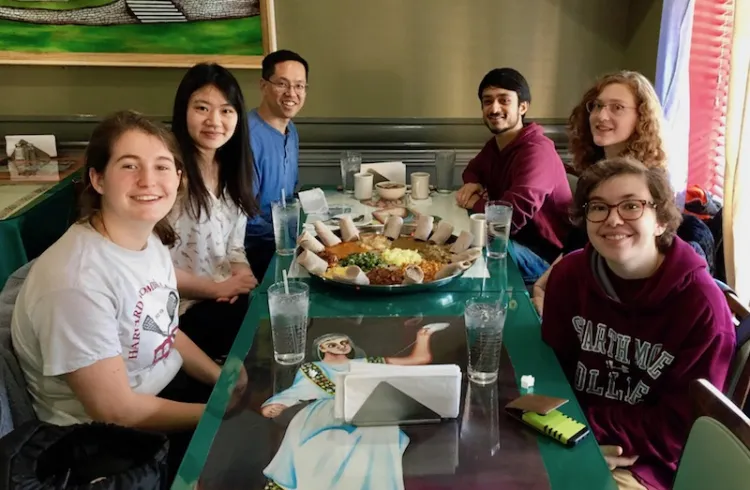For Professor of Statistics Steve C. Wang, nothing beats watching his students take ownership of a research project.
“I tell them they’re now one of the world’s leading experts in their topic,” says Wang, “although they don’t always believe me.”
The notion rang true at the Geological Society of America (GSA) Annual Meeting in Indianapolis in November, where Wang, four students, and an alumna presented their shared research on statistical paleontology. They got to interact with—and make their mark on—a community of the world’s leading geoscientists.
“I really enjoyed my conversations and the opportunity to learn about cool, new science while communicating our results and methods to an interested and knowledgeable audience,” says Harsha Sen ’19, a biology and economics major from Clifton, N.J. “The experience of traveling to a new city with my peers and professor Wang was exciting, and the chance to explain my work was extremely fulfilling.”
Joining Wang and Sen on the research projects were Clara Habermeier ’17, a content manager for Pluto TV who studied economics at Swarthmore; Madison Shoraka '20, a mathematics and peace & conflict studies major from Rockville, Md.; Haochen Wang '20, a computer science and mathematics major from Lexington, Mass.; and Melissa Zavez '20, a computer science major from Winchester, Mass.
The team presented on two posters: Are We Entering a Sixth Mass Extinction: Age Selectivity of Modern Extinctions and Estimating the Duration of the Cambrian Explosion.
“They did a fantastic job of explaining their work,” says Wang. “There was a steady stream of people stopping by the posters, and it was great to see the students sharing their expertise and the results of their hard work.”

“It’s so valuable for students to get a chance to meet researchers from the larger scientific community beyond Swarthmore,” says Wang, “and realize that they are a part of that community as well.”
The students have spent a long time working on their projects, over a year in some cases, he says, “and it’s great for them to have a culminating experience where they can share what they have discovered.”
Adds Haochen Wang: “I thought the conference was a nice opportunity to share our progress so far and receive feedback.”
As an undergraduate institution with no geology or paleontology major, Swarthmore might not seem like a natural fit for the GSA. But the College once again impressed at the meeting, following the presentations from four students in 2016.
“Five is the most [students and/or alumni] I have ever brought to a conference,” says Wang. “My impression is that it’s a high number.”
The research process for the posters attests to the central role of student-faculty collaboration at Swarthmore. The team also partnered with Zoey Werbin ’17, now a graduate student in biology at Boston University, whose previous collaboration with Wang sparked the “Are We Entering a Sixth Mass Extinction” poster, and John Wojciehowski ’19, a mathematics and theater major from Mercer Island, Wash., who could not attend the conference.
It also demonstrated the College’s connections to the larger scientific community, as the team collaborated with scientists from Princeton, Stanford, UC Santa Barbara, and UC Berkeley.
“It’s so valuable for students to get a chance to meet researchers from the larger scientific community beyond Swarthmore,” says Wang, “and realize that they are a part of that community as well.”
Swarthmore is investing in its vibrant intellectual culture. Learn how at lifechanging.swarthmore.edu.



